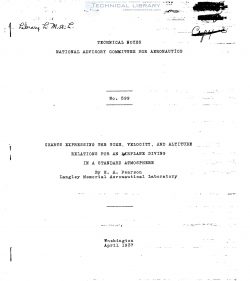naca-tn-599
- Version
- 153 Downloads
- 935.92 KB File Size
- 1 File Count
- November 25, 2016 Create Date
- November 25, 2016 Last Updated
National Advisory Committee for Aeronautics, Technical Notes - Charts Expressing the Time, Velocity, and Altitude Relations for an Airplane Diving in a Standard Atmosphere

In this report charts are given showing thpmrelation
between time, velocity, and altitude for airplanes having
various terminal velocities diving in a standard atmos-
phere. The range of starting altitudes is from 8,000 to
32,000 feet, and the terminal velocities vary from 150 to
550 miles per hour. A comparison is made between an ex~
perimental case and the results obtained from the charts}
Examples pointing out the use of the charts are included.
The velocity—altitude relations for airplanes in a
dive have been treated in the past by several writers.
Diehl (reference 1) assumed a constant density atmosphere.
Wilson (reference 2) and Becker (reference 3), who have
taken the variation of density into account, though attack—
ing the problem differently, have given no expression for_
the time to dive.. Regardless of the manner in which the
density is taken into account, the velocityQaltitude equa—
tions become too lengthy and complicated for general use.
Because of this fact, and also because the time varia-
ble has previously been omitted, it is the purpose of this
paper to present in a readily usable form charts express-
ing_all three relations with density variation taken into
account.
The charts shown in figures 1 to 9 cover a range of
terminal velocities from 150 to 550 miles per hour by 50—
mile—per~hour increments. The starting altitudes vary
from 8,000 to 16,000 feet by 2,000—foot intervals, and
from 16,000 to 32,000 feet by 4,000—foot increments. This
latitude in both speed and_altitude will, it is believed,
cover all cases of interest from the extremely slow air-
plane up to the fastest airplane available.
The terminal velocity U by which each chart is des-
ignated, is that which would be obtained in an atmosphere
of constant sea~level density. The abscissas of the curves
are the true, not the indicated velocities.
| File | Action |
|---|---|
| naca-tn-599 Charts Expressing the Time, Velocity, and Altitude Relations for an Airplane Diving in a Standard Atmosphere.pdf | Download |

Comment On This Post